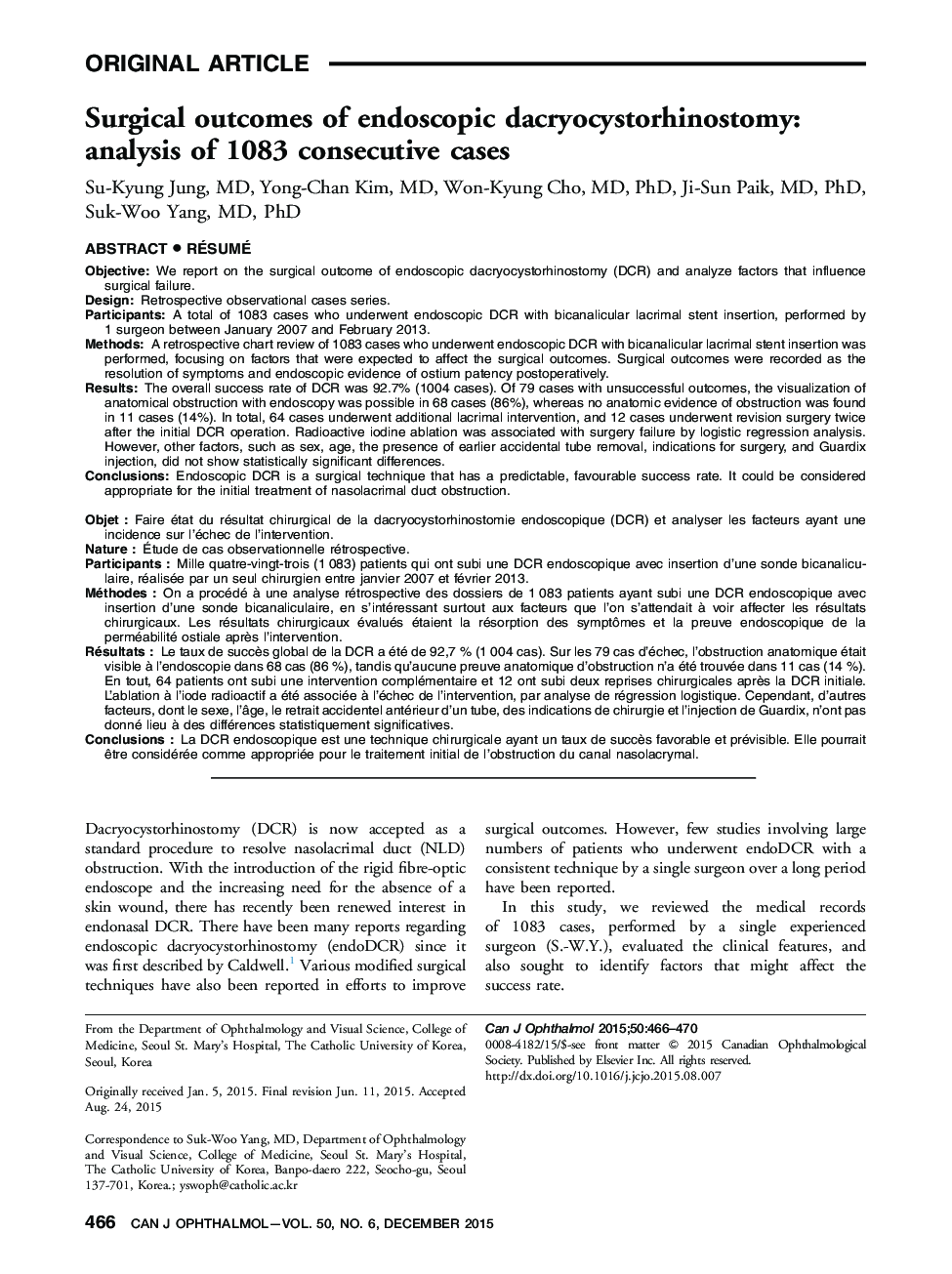| Article ID | Journal | Published Year | Pages | File Type |
|---|---|---|---|---|
| 4008996 | Canadian Journal of Ophthalmology / Journal Canadien d'Ophtalmologie | 2015 | 5 Pages |
ObjectiveWe report on the surgical outcome of endoscopic dacryocystorhinostomy (DCR) and analyze factors that influence surgical failure.DesignRetrospective observational cases series.ParticipantsA total of 1083 cases who underwent endoscopic DCR with bicanalicular lacrimal stent insertion, performed by 1 surgeon between January 2007 and February 2013.MethodsA retrospective chart review of 1083 cases who underwent endoscopic DCR with bicanalicular lacrimal stent insertion was performed, focusing on factors that were expected to affect the surgical outcomes. Surgical outcomes were recorded as the resolution of symptoms and endoscopic evidence of ostium patency postoperatively.ResultsThe overall success rate of DCR was 92.7% (1004 cases). Of 79 cases with unsuccessful outcomes, the visualization of anatomical obstruction with endoscopy was possible in 68 cases (86%), whereas no anatomic evidence of obstruction was found in 11 cases (14%). In total, 64 cases underwent additional lacrimal intervention, and 12 cases underwent revision surgery twice after the initial DCR operation. Radioactive iodine ablation was associated with surgery failure by logistic regression analysis. However, other factors, such as sex, age, the presence of earlier accidental tube removal, indications for surgery, and Guardix injection, did not show statistically significant differences.ConclusionsEndoscopic DCR is a surgical technique that has a predictable, favourable success rate. It could be considered appropriate for the initial treatment of nasolacrimal duct obstruction.
RésuméObjetFaire état du résultat chirurgical de la dacryocystorhinostomie endoscopique (DCR) et analyser les facteurs ayant une incidence sur l’échec de l’intervention.NatureÉtude de cas observationnelle rétrospective.ParticipantsMille quatre-vingt-trois (1 083) patients qui ont subi une DCR endoscopique avec insertion d’une sonde bicanaliculaire, réalisée par un seul chirurgien entre janvier 2007 et février 2013.MéthodesOn a procédé à une analyse rétrospective des dossiers de 1 083 patients ayant subi une DCR endoscopique avec insertion d’une sonde bicanaliculaire, en s’intéressant surtout aux facteurs que l’on s’attendait à voir affecter les résultats chirurgicaux. Les résultats chirurgicaux évalués étaient la résorption des symptômes et la preuve endoscopique de la perméabilité ostiale après l’intervention.RésultatsLe taux de succès global de la DCR a été de 92,7 % (1 004 cas). Sur les 79 cas d’échec, l’obstruction anatomique était visible à l’endoscopie dans 68 cas (86 %), tandis qu’aucune preuve anatomique d’obstruction n’a été trouvée dans 11 cas (14 %). En tout, 64 patients ont subi une intervention complémentaire et 12 ont subi deux reprises chirurgicales après la DCR initiale. L’ablation à l’iode radioactif a été associée à l’échec de l’intervention, par analyse de régression logistique. Cependant, d’autres facteurs, dont le sexe, l’âge, le retrait accidentel antérieur d’un tube, des indications de chirurgie et l’injection de Guardix, n’ont pas donné lieu à des différences statistiquement significatives.ConclusionsLa DCR endoscopique est une technique chirurgicale ayant un taux de succès favorable et prévisible. Elle pourrait être considérée comme appropriée pour le traitement initial de l’obstruction du canal nasolacrymal.
